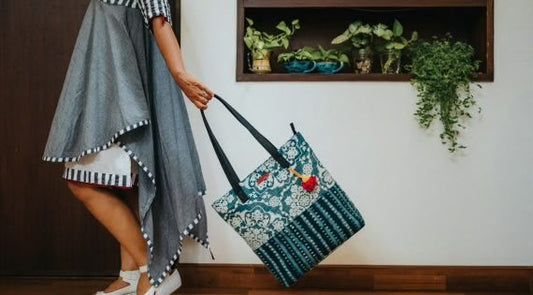A lot of us have heard the word shibori, but do we really understand what goes behind making a shibori dress and how is it really done or where does it originate from?
Here in this blog “Art of Shibori” we are going to explain what is Shibori, its History, techniques, and presence in India. I hope that after knowing this craft in detail you would definitely want to possess a Shibori dress in your wardrobe.
So let’s start….
What is the Art of Shibori
Shibori is a technique that implicates tying, gathering or twisting a piece of cloth in a particular way before it is dyed. This creates a unique pattern that results from permitting the color to penetrate certain portions of the fabric only.
It’s a very ancient technique, demanding a high level of knowledge, skill, and time. This is also sure that if done in the right manner, the outcome is amazingly beautiful.
History of Shibori
The word has become a somewhat extensive term to describe any of the several methods that involve the shape-resist dyeing of a textile. It is derived from the Japanese verb shibori, which means to squeeze, wring or press.
Even though Shibori is a Japanese word, is just not limited to Japan. Based on the information available, the art of Shibori did not even originate in Japan – along the Chinese Silk Road, expensive pieces of Shibori silk have been recovered from tombs that have laid hidden for over 1500 years.
Shibori-dyed alpaca wool, created by people who existed over a millennium ago, has been found in areas of South America. Countless cultures and people around the world have over the centuries developed their own version of shape-resist dyeing. Two distinct Malay-Indonesian terms – Plangi and Tritik – refer to two different methods of the art.
In India, the word Bandhani – derived from the Sanskrit verb banda (to bind) – defines the same process of tying or assembling fabric in such a way as to let the dye to arrange itself into certain patterns.
In the USA and Britain, most of us know it commonly as tie-dye, a psychedelic hangover handed to us by 1960s counter-culture – legend has it that Janis Joplin slept on tie-dyed satin sheets.
The art slowly faded out of vogue after the psychedelic boom of the sixties. Nevertheless, in recent years it has made a comeback, with current artists and designers combining these ancient techniques with contemporary cuts, subtle neutral shades, and modern styling.
Shibori Techniques

This art actually involves somewhat a number of different resist-dyeing techniques. The most common ones are mentioned below:
-
Kanoko shibori
Similar to tie and dye, this technique involves elastic bands to bind cloth tightly before dyeing, forming an organic-looking pattern.
-
Miura shibori
In this Miura technique, the craftsmen pinch small sections of fabric and loop thread around them to create a particular repeated pattern.
-
Arashi shibori
It is also known as pole-wrapping shibori. In Arashi, the fabric is tightly twisted around a pole, tied into place with thread, and wrinkled to create a pattern. The outcome is a diagonal, linear design.
-
Kumo shibori
In this Kumo Shibori technique, small objects like pebbles are bound with thread into fabric. This will result in beautiful circular, web-like patterns.
-
Nui shibori
This is a bit complex technique and it uses stitching to create accurate cinched patterns in the fabric. The stitching is removed once the dying is completed.
-
Itajime shibori
Instead of using binding and cinching to create patterns, this technique requires the use of shaped blocks (usually of wood, though sometimes of plastic) between which folded fabric is sandwiched to get the desired pattern.
Shibori in India 
It was introduced to India in the early 20th century, apparently by Nobel Laureate, Rabindranath Tagore. It is now practiced in craft clusters in Delhi, Rajasthan, and Gujarat though the quality and mastery of shibori is very much advanced in Japan.
Regionally-developed techniques for fabric manipulation and dying have existed for ages in the sub-continent; the most common among them is bandhani.
Bandhani derives from the Sanskrit word banda denotes “to tie” and developed during the Indus River Civilisation, where the earliest evidence of dying dates back to 4000 BC. Though, today we are familiar with the typical bandhani style of concentrations of small dots dates back to the 6th century AD where proof of this style is found in the Ajanta caves.
Bandhani makes use of almost every color under the rainbow, though the main colors used are red, yellow, blue, green, and black. Nowadays Bandhani practiced only in the areas where it was developed – Sindh (Pakistan), Punjab, Gujarat, and Rajasthan (India). Bandhani is a technique of creating patterns in cloth by covering small pinches of fabric with thread and creating geometric patterns through the concentration of small dots.
One more popular technique practiced in India is leheriya; leher meaning “waves of the ocean”. This technique is practiced in just a few areas of Rajasthan, making it quite unique. Leheriya is created through an intricate method of rolling, folding, and re-rolling the fabric to create waves.
Wrap Up

In the contemporary day, you can find clothing made from shibori textiles with several brands in India. Our brand AMAR KOSA is vastly indulging in ethically sourced Natural Handloom fabrics like cotton, linen, hemp, flax, silks, and even organic cotton; infused with Hand block printing, Shibori, or Tie & Dye.
Last year during the lock-down, what started as a fun activity to engage my kids turned into a fully bloomed shibori collection at AMAR KOSA.

We have a vast and unique collection of Shibori dresses which you can check out at our online store here as well as at our fashion studio in Bangalore.




